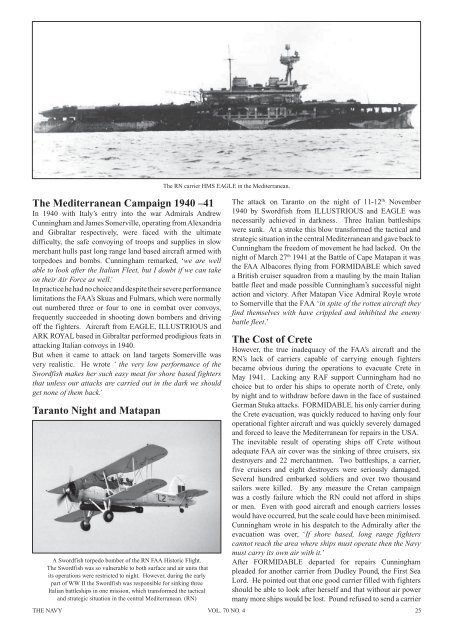The Navy Vol_70_No_4 Oct 2008 - Navy League of Australia
The Navy Vol_70_No_4 Oct 2008 - Navy League of Australia
The Navy Vol_70_No_4 Oct 2008 - Navy League of Australia
You also want an ePaper? Increase the reach of your titles
YUMPU automatically turns print PDFs into web optimized ePapers that Google loves.
<strong>The</strong> Mediterranean Campaign 1940 –41<br />
In 1940 with Italy’s entry into the war Admirals Andrew<br />
Cunningham and James Somerville, operating from Alexandria<br />
and Gibraltar respectively, were faced with the ultimate<br />
difficulty, the safe convoying <strong>of</strong> troops and supplies in slow<br />
merchant hulls past long range land based aircraft armed with<br />
torpedoes and bombs. Cunningham remarked, ‘we are well<br />
able to look after the Italian Fleet, but I doubt if we can take<br />
on their Air Force as well.’<br />
In practice he had no choice and despite their severe performance<br />
limitations the FAA’s Skuas and Fulmars, which were normally<br />
out numbered three or four to one in combat over convoys,<br />
frequently succeeded in shooting down bombers and driving<br />
<strong>of</strong>f the fighters. Aircraft from EAGLE, ILLUSTRIOUS and<br />
ARK ROYAL based in Gibraltar performed prodigious feats in<br />
attacking Italian convoys in 1940.<br />
But when it came to attack on land targets Somerville was<br />
very realistic. He wrote ‘ the very low performance <strong>of</strong> the<br />
Swordfish makes her such easy meat for shore based fighters<br />
that unless our attacks are carried out in the dark we should<br />
get none <strong>of</strong> them back.’<br />
Taranto Night and Matapan<br />
A Swordfish torpedo bomber <strong>of</strong> the RN FAA Historic Flight.<br />
<strong>The</strong> Swordfish was so vulnerable to both surface and air units that<br />
its operations were restricted to night. However, during the early<br />
part <strong>of</strong> WW II the Swordfish was responsible for sinking three<br />
Italian battleships in one mission, which transformed the tactical<br />
and strategic situation in the central Mediterranean. (RN)<br />
<strong>The</strong> RN carrier HMS EAGLE in the Mediterranean.<br />
<strong>The</strong> attack on Taranto on the night <strong>of</strong> 11-12 th <strong>No</strong>vember<br />
1940 by Swordfish from ILLUSTRIOUS and EAGLE was<br />
necessarily achieved in darkness. Three Italian battleships<br />
were sunk. At a stroke this blow transformed the tactical and<br />
strategic situation in the central Mediterranean and gave back to<br />
Cunningham the freedom <strong>of</strong> movement he had lacked. On the<br />
night <strong>of</strong> March 27 th 1941 at the Battle <strong>of</strong> Cape Matapan it was<br />
the FAA Albacores flying from FORMIDABLE which saved<br />
a British cruiser squadron from a mauling by the main Italian<br />
battle fleet and made possible Cunningham’s successful night<br />
action and victory. After Matapan Vice Admiral Royle wrote<br />
to Somerville that the FAA ‘in spite <strong>of</strong> the rotten aircraft they<br />
find themselves with have crippled and inhibited the enemy<br />
battle fleet.’<br />
<strong>The</strong> Cost <strong>of</strong> Crete<br />
However, the true inadequacy <strong>of</strong> the FAA’s aircraft and the<br />
RN’s lack <strong>of</strong> carriers capable <strong>of</strong> carrying enough fighters<br />
became obvious during the operations to evacuate Crete in<br />
May 1941. Lacking any RAF support Cunningham had no<br />
choice but to order his ships to operate north <strong>of</strong> Crete, only<br />
by night and to withdraw before dawn in the face <strong>of</strong> sustained<br />
German Stuka attacks. FORMIDABLE, his only carrier during<br />
the Crete evacuation, was quickly reduced to having only four<br />
operational fighter aircraft and was quickly severely damaged<br />
and forced to leave the Mediterranean for repairs in the USA.<br />
<strong>The</strong> inevitable result <strong>of</strong> operating ships <strong>of</strong>f Crete without<br />
adequate FAA air cover was the sinking <strong>of</strong> three cruisers, six<br />
destroyers and 22 merchantmen. Two battleships, a carrier,<br />
five cruisers and eight destroyers were seriously damaged.<br />
Several hundred embarked soldiers and over two thousand<br />
sailors were killed. By any measure the Cretan campaign<br />
was a costly failure which the RN could not afford in ships<br />
or men. Even with good aircraft and enough carriers losses<br />
would have occurred, but the scale could have been minimised.<br />
Cunningham wrote in his despatch to the Admiralty after the<br />
evacuation was over, ‘If shore based, long range fighters<br />
cannot reach the area where ships must operate then the <strong>Navy</strong><br />
must carry its own air with it.’<br />
After FORMIDABLE departed for repairs Cunningham<br />
pleaded for another carrier from Dudley Pound, the First Sea<br />
Lord. He pointed out that one good carrier filled with fighters<br />
should be able to look after herself and that without air power<br />
many more ships would be lost. Pound refused to send a carrier<br />
THE NAVY VOL. <strong>70</strong> NO. 4 25

















